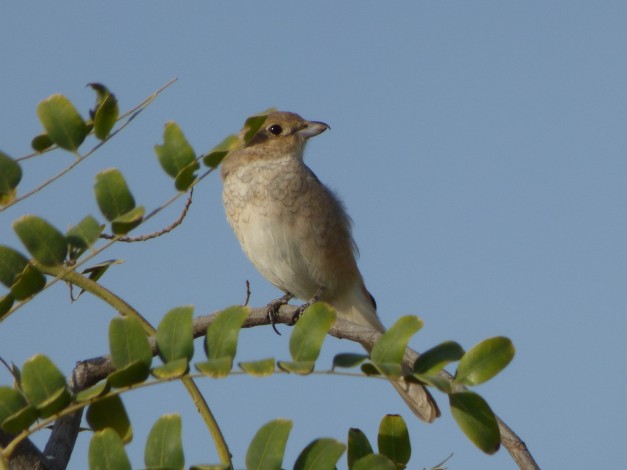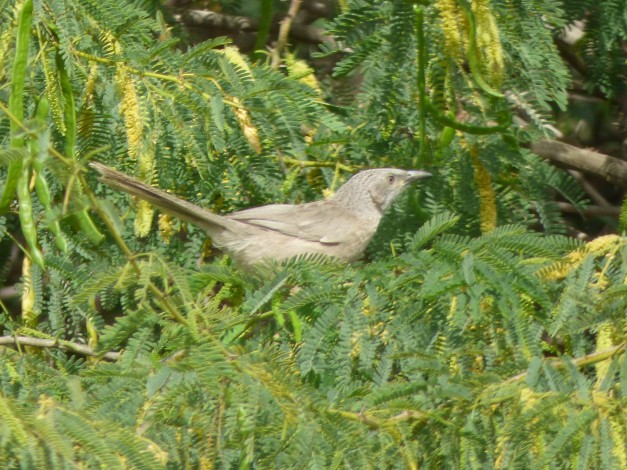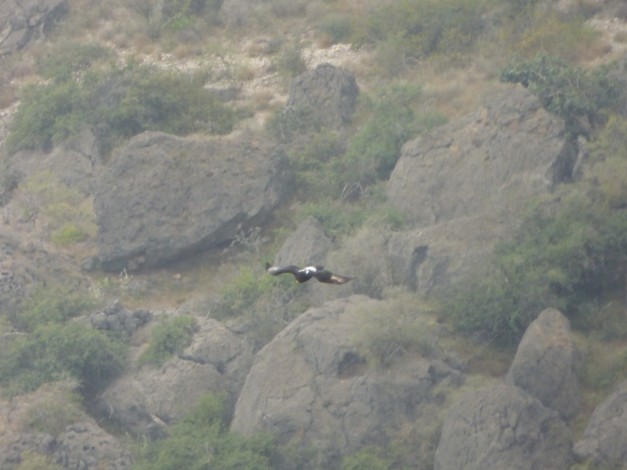Oman Birding Tour 2019 Trip Report
Dates: 29th January to 7th February, 2019
Tour participants: 5
Seen bird species: 210
Tour Leaders: Sergi Sales & Carles Oliver
After an afternoon flight we arrived to Oman beyond midnight. Passport controls were fast and we arrived to our hotel in Musqat after a comfortable shuttle transport from the aiport.
Day 1. After a good rest and a great breakfast in our hotel we went for a short walk in some tree just by our accommodation. It was time to have a first contact with some common species in Northern Oman. Probably the first bird of the tour were 2 Purple Sunbirds, seen feeding in the trees along a small gorge. Just around, a wonderful Indian Roller was hunting from the wires crossing the gorge. Indian Silverbill, Common Myna and several Laughing Doves were also seen and celebrated. We also had the interesting local race of House Sparrow, being smaller, duller and more grey in the upperside than the races we are more used.
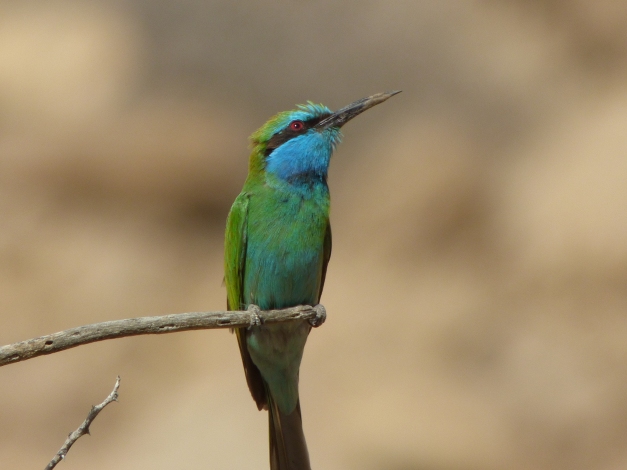
After this small taste by our hotel we drove a short distance to explore the Al Ansad Wetland. This is a small complex of lagoons with riparian vegetation that can be really productive. A first scanning produced Black-headed Lapwings, Crested Larks, Purple Sunbirds, White-spectacled Bulbuls and 1 White Wagtail. A juvenile Bonelli’s Eagle just passed over us giving excellent views in the morning light.
The firs lagoon was really productive. It hosted a good selection of ducks including Mallards, Gadwalls, Eurasian Wigeons, Pintails, Eurasian Teals, Tufted Ducks and Common Pochards. About 20 Greater Flamingos were roosting in the lagoon joined by 5 Eurasian Spoonbills. Black-winged Stilts, Ruffs and 1 Black-tailed Godwit were feeding inmediatly around. By the reedbeds we found 1 Eurasian Coot along with several Eurasian Moorhens and Little Grebes. Grey Heron, Cattle Egret and Great White Egrets were also present in small numbers.
Temminck’s Stints were common with at least 8 birds feeding along with some Little Stints. At least 3 Marsh Sandpipers were also present along with several Common Sandpipers. The good scanning of the area produced as well 1 Citrine Wagtail and 2 Yellow Wagtail (one of them being a male beema race). Some Common Snipes flought off and the Bonelli’s Eagle came back and had a second flight over the water. Was in that moment that the only White-tailed Lapwing of the trip came up from behind a sand bar and we all could enjoy good views on the bird for a pair of minutes. This was already a good start!
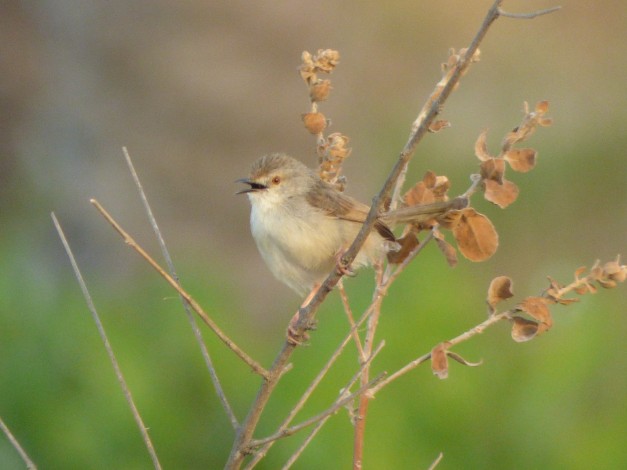
Unfortunably the bird was a bit far and came down again to the opposite side of the bank. We spent several minutes trying to relocate the bird, but was impossible.
Happy after such a good start we just moved on along the path. Not far from there we were distracted by the first of several Graceful Prinias singing from the top of a bus. A closer view was demanded so we moved on just at the moment than a flock of Sand Partridges flew off from under our feet! After some good shots in the Prinia our attention was concentrated by a very close Little Green Bee-eaters catching insects at short range. Its footage from the minor branches of a small tree was really productive in photographic terms!
The area was still producing interesting sightings. A group of White cheecked Bulbuls were moving in the bushland and 1 Indian Silverbill was busy while bringing nest material inside a small tree. The same juvenile Bonelli’s Eagle that we saw flying over the lagoon was now sheltered by the shade of a small cliff. A last walk in the area produced some Great Cormorants, the first Greater Spotted Eagle high up in the sky and good views in 1 rather unexpected Eastern Orphean Warbler skulking inside a bush!
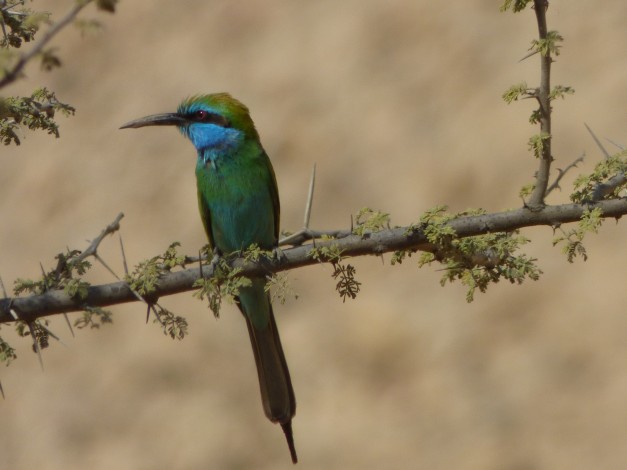
We then went to the coast, where we had some food near the beach while we were scanning around. Here we had several Heuglin’s Gulls moving in the coast along with the commoner Black-headed Gull. Also some Caspian Gulls were seen, mainly adults. 2 Sooty Gulls passed by but unfortunately a bit far away for everybody in the group to enjoy them. At least 2 Great Crested Terns were moving in the coast and we had really good views as one approached the dock where we were scanning from. A tiny wady in our way was also providing good birds, special mention to our first Greater Sand Plover, Pacific Golden Plover along with Common Sandpiper and Common Redshank.
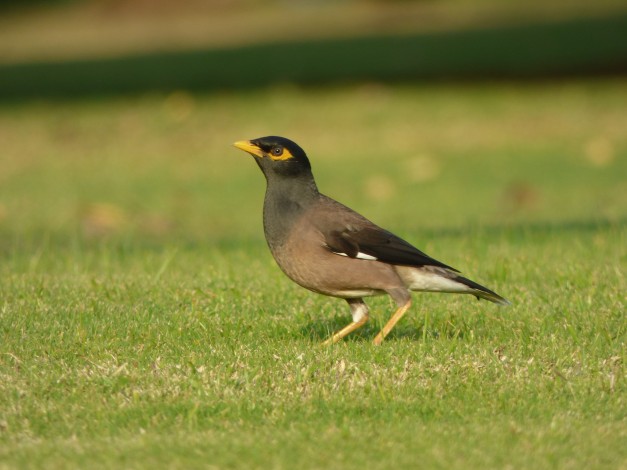

We decided to spend the rest of the day in Al Qurm Park. This is a well known birding spot in Musqat hosting some very interesting specialities. Our arrival to park was really good as 1 Indian Roller was hunting in the parking and only few metres inside the park we had our first Grey Francolin of the trip running up the slope. In the trees, a Common Chiffchaff was seen (here presumably all Chiffchaffs belong to abietinus or tristis races, thought now Siberian Chiffchaff is claimed as a diferent species for some). A small channel of water connects the big central lagoon of the park with the sea. This channel proved to be really productive as we fastly spotted 1 Striolated Heron hidden in the shady bank. Few metres away from it we found 1 Acrocephalus. Silence and check for some seconds before confirming that was a Clamorous Reed Warbler! This was a bird really celebrated by the group. The bird provided really good views in the out for quite long, moving always really low in the vegetation, but clearly in the out. The channel itself was attrackting some Pallid Swifts to drink water and we all enjoyed lovely views on these birds. A Purple Heron flew over and its shade made Common Sandpipers and Black-headed Lapwings move away. Inside the park we enjoy a new Indian Roller until a small shrike was located in the top of the tree. At first it looked like a Isabelline but finally it turned up to be a Red-tailed Shrike, a recent split from the former.
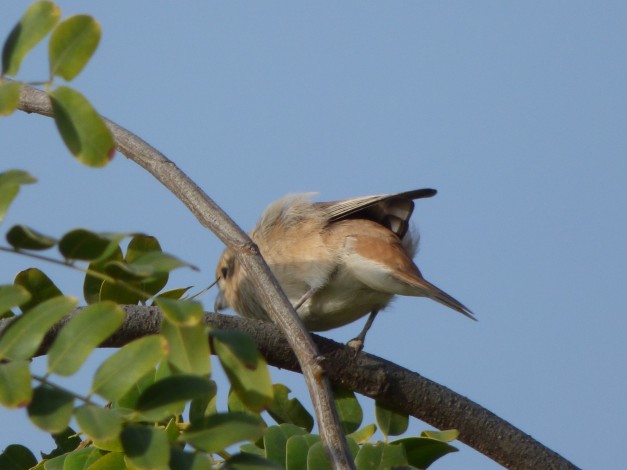
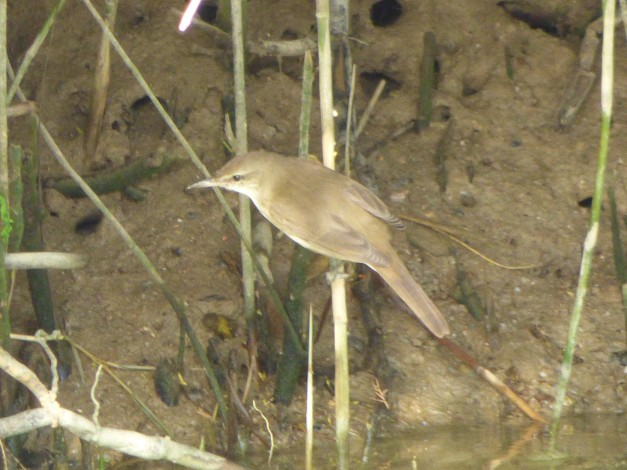
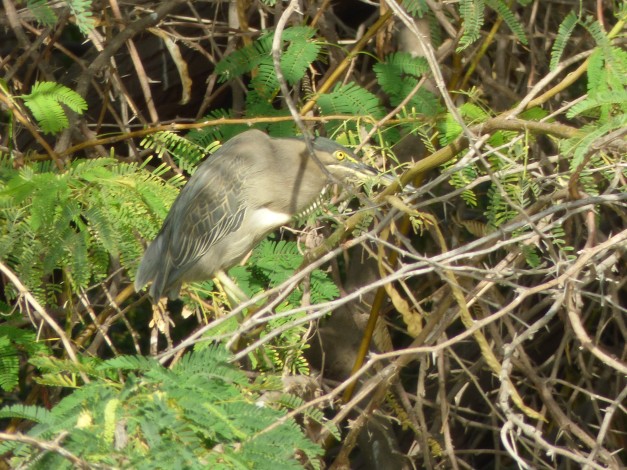
The central pond was low of water but as good as always. 1 Whiskered Tern was flying over and 1 Western Reef Egret was fishing along with some Cattle Egrets. Fastly our attention was for “Squacco like” herons around the pond. After some scanning we found the 2 firsts Indian Pond Heron of the tour, feeding along with 4-5 Squacco Herons. Little Grebes and Eurasian Coots were also present in the pond.

We still had a further walk around the trees. Rose-winged Parakeets were everywhere and a Alexandrine Parakeet was heard in the air. It was time to go but then we found a wonderful tree full of Common Chiffchaff, Purple Sunbirds and at least two Lesser Whitethroats (Desert Whites?). As the area proved really interesting we decided to spend the rest of the afternoon in around. A short walk from the park allowed us to explore some tidal muds richly vegetated. Here we found some interesting passerines including Isabelline Shrike, 2 Bluethroats and Eurasian Reed Warbler. Some waders were present in the small mudflats including several Eurasian Whimbrel, 1 Eurasian Curlew, 15+ Spotted Redshank, Dunlin, Ruff, Little Ringed Plover and some Common Ringed Plover. 1 Intermediate Egret flew over us in its way to the sea and 1 Garganey took off from a tiny patch of marsh but the best bird in the spot was a Pin-tailed Snipe that took off along with 1 Common Snipe from the flooded areas. Some Snipes were moving around so we carefully checked every single bird leaving the area. At least 15 Common Snipes left in different waves and we got good views in 1 Spin-tailed showing the remarcable blackish uderwings and contrasted belly.
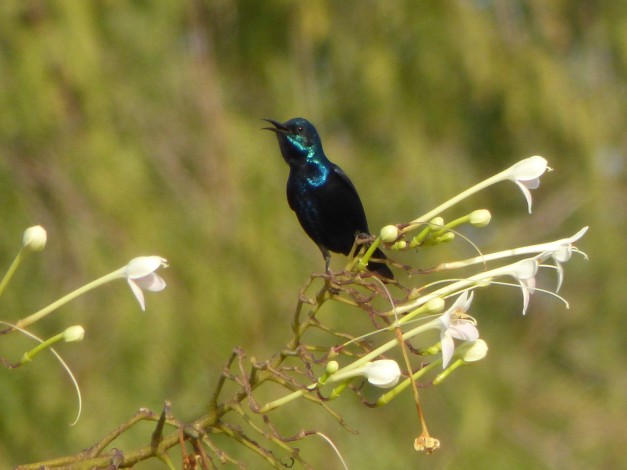
Happy after such a great encounteer we still looked for something else in this corner. Some Eurasian Moorhens were seen feeding in the grassy areas and 1 Grey Heron arrived for a evening meal. The time of our own evening meal was not far any more so we left the area for a good rest in the hotel and a dinner to go throught all the birds of our first day in Oman.
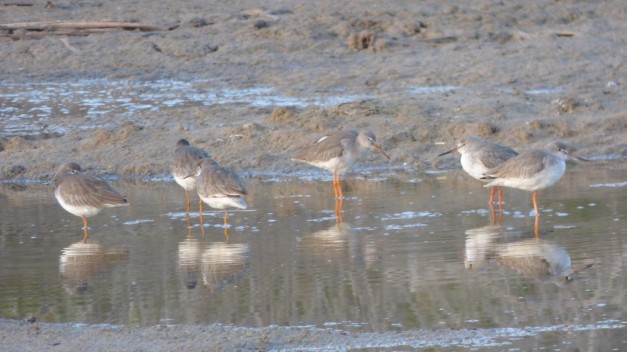
Day 2. After our good buffet breakfast we left our hotel to explore the Western coast of Northern Oman. But, as tyde was low, before going West we came back for a while to Al Qurm beach. Just arriving we found a small flock of gulls in the beach along with some terns. A fast scan revealed some Great Crested Terns along with Sandwich Terns. Most of the gulls were the splitable Steppe Gull (Larus fuscus babarensis) and got good views and comparision of structure with a lovely Caspian Gull adult. Heuglin’s Gulls were also present in the flock, including different ages and intermediate plomages. Not far after we found the first Palla’s Gull, a 3rd year bird. What a incredible gull! Not only the shape of bill but the general structure of the bird was simply massive. Here, all tour participants enjoyed very much with this flock of gulls and having adults of Caspian, Steppe, Heuglin’s and Palla’s all together in a small flock was really celebrated and appreciated for everybody! Small flocks of Slender-billed Gulls were also present at the beach.
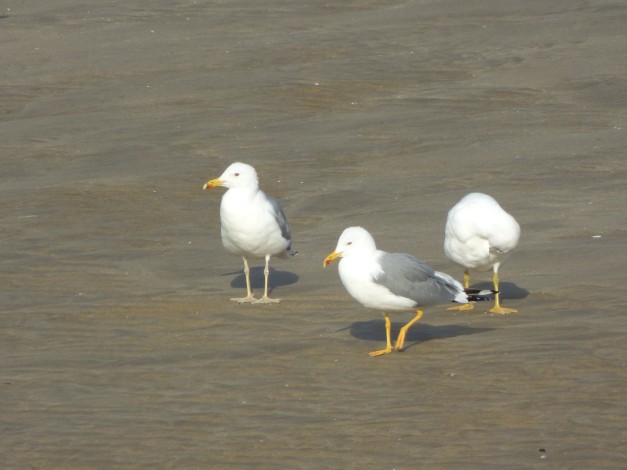
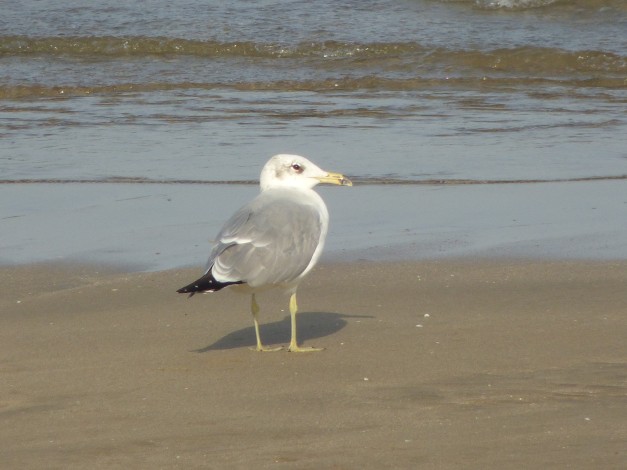
Around the flock of gulls there were some waders and it didn’t take long to spot some Lesser Sand Plovers moving in the sand. There were about 30 individuals in different smalls flocks. Here we also had Greenshank, Kentish Plover, Whimbrels, Common Redshank, Western Reef Heron in light form (less common in the area) and Lesser Crested Tern. Again, we enjoyed views on Lesser Crested Terns side by side with Great Crested Terns so a good comparision on sizes, structure and colour could be made. Some Sooty Gulls were also flying around but we only had a single bird stopping on the ground. We spend some time enjoying these gulls and terns but also scanning around looking for other specialities. Some scouting inland produced 6 Common Snipe sleeping on the grass, Black-headed Lapwings, Common Kingfisher and Graceful Prinia and 2 Grey Francolins having a sand bath.
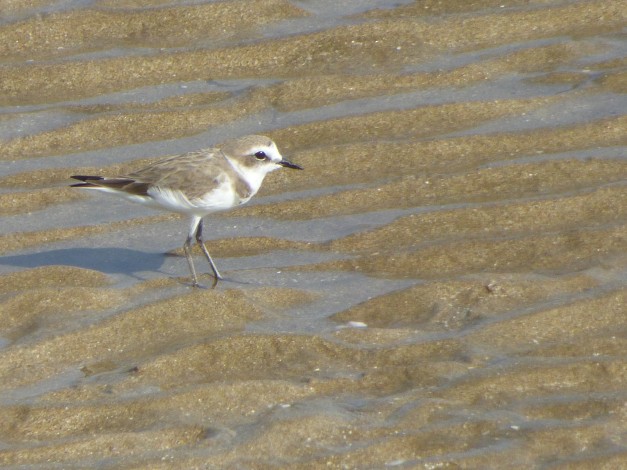
Back to the sea shore, we had big flocks of Great Cormorants flying around and we enjoyed how fast they moved as the nets of the fishermen were into the water. A nice espectacle to be seen! More plovers were arriving from the East, clearly bigger and heavier than all species around; 8 Great Sand Plovers! Again, a good comparision on size, shape and facial pattern was made with its relative the Lesser Sand Plover…
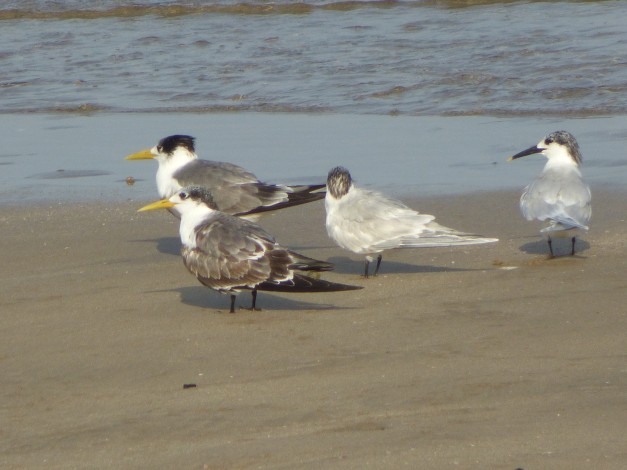
After such a wonderful stop we then drove to the West, towards the Sun Farms. These are water-assisted grassy crops being a magnet for a good number of species. Despite some reports of the explotation being abandoned from some years ago, we decided to approach and take a look. It was an excellent decision, as you will see.
We arrived to the area were the Sun Farms were and well, it was no sign of any grass anywhere. Still, even before arrived to the exact place we were obligated to stop the car and walk around as a family group of Arabian Babblers were moving just by the track. Unfortunately not everybody in the van enjoyed excellent views so we parked the car and walk around looking for this wonderful bird.
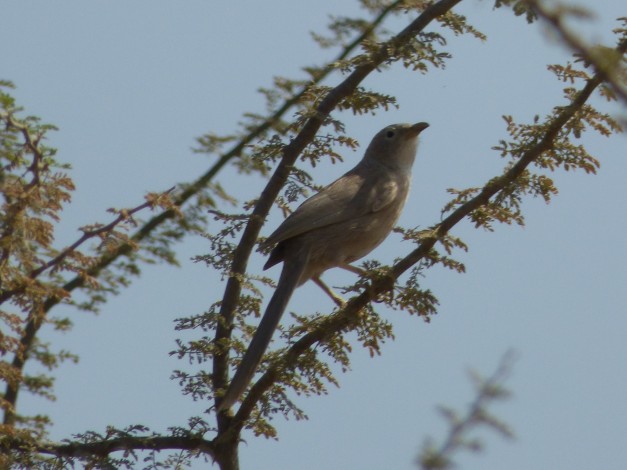
The flock of birds were still moving around in the semi-desert so we decided to do a short walk around expecting to improve our sight. Purple Sunbirds were everywhere and a nice flock of lined Indian Silverbills was welcome by the photographers in the group. A Common Kestrel was circling up in the sky among Pallid Swifts and Crested Larks were singing and moving all around. In a shade, a Tawny Pipit showed really well for a pair of minutes while 1 Hoopoe was diving its bill on the sand looking for warms, but still no signal of the Babblers. While searching for them we had another really good bird appearing. A characteristic «txac» call came from the acacias around us and, after some scanning, we all had excellent views on 2 Hume’s Whitethroat! This is a quite recent Split from Lesser Whitethroat inhabitating juniper formations in Iran and Afghanistan high mountains. They are easy to tell apart by calls but also due to the clearly darker head, auriculars and nape of the Hume’s if compared with Lesser. The back and mantle in Hume’s Whitethroat is also darker than in Lessers, showing really little contrast.
A further scanning in the area still produced a nice male Black Redstart of the Eastern phoenicuroides race and a superb male Pallid Harrier flying around and stopping in the low branches of a distant tree for some minutes. Namaqua Doves were passing over us and we could count up to 8 individuals of this beautiful bird. It was a very productive corner but since no signal of the Babblers around we decided to go on but, just when most of the people was in the car, we had 2 Arabian Babblers coming to us and stopping some 60 metres from us. More and more birds came front he tangles and we arrived to count up to 9 of them!
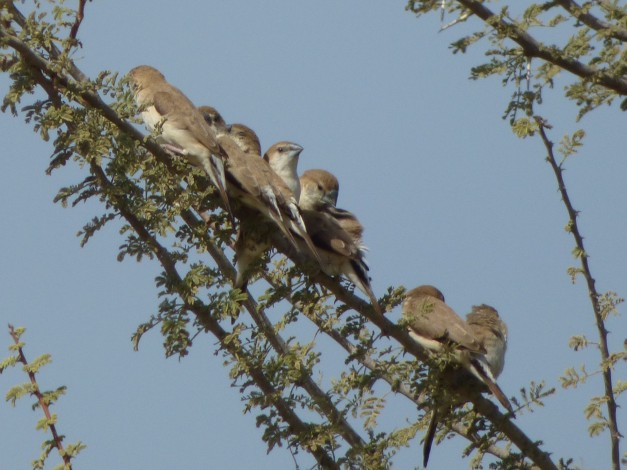
We had the birds around for some minutes in what was a really unexpected encounteer in one of the most difficult species in the area! We moved but we didn’t really arrived that far away since we fastly found 1 male Black-crowned Sparrow-Lark some 35 metres from us. Not far, an obliging Isabelline Weathear was a good first for the trip.
It was time to go to our next location. A short drive allowed us to arrive to Liwa mangroves. This is home of two of the most wanted species for all birdwatchers coming to Oman: Collared Kingfisher and Sykes Warbler.
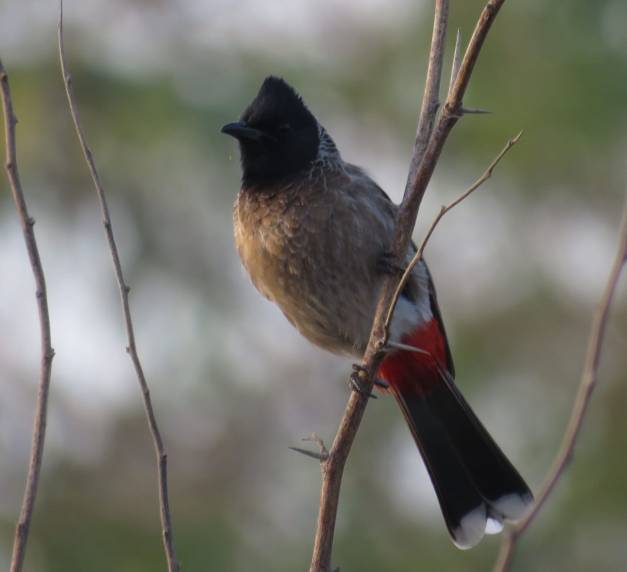
Tyde was low and we decided to go on with a short walk along the mangroves. Sooty Gulls were really common as walked in the beach and good numbers of Slender-billed Gulls were also seen flying around. Great Crested Tern was less common, with only few moving along the shore.
In the mangroves it was little movement. A small flock of Eurasian Whimbrels were looking for some food in the mud, joined by 4 Spotted Redshanks. A pair of Common Sandpipers were typically moving up and down along the shores. It was time for a bit of scan and most efforts were placed in the most suitable channel to host a Collared Kingfisher. After 15 minutes of scanning a chunky, white shade emerged from the mangroves to stop in outer skinny branches of a dead mangrove. This was a wonderful views even if not specially close. Things improved really much when the bird turned, showing the typical collar and the beautiful blue-greenish in the upperparts. This view was really celebrated by the group. A Common Kingfisher joined its relative for a better comparision of shape and size.
The bird showed for about 2 minutes and after that came back deep inside the mangrove. We still waited, hoping for a better view and some photo chances that never arrived. Still, the group was really happy to see such a scarce bird! Remember that Collared Kingfishers living at Arabian Peninsula are from “kalbaensis” race, an extremely endangered and more than a probable coming split from the nominal race living in most of Asia!!
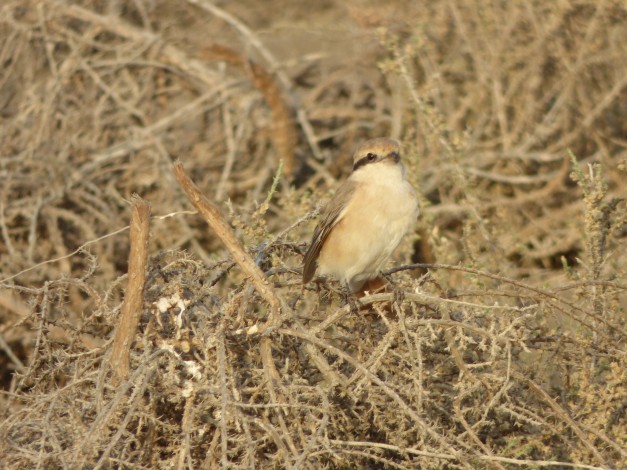
More than happy about this wonderful sight we kept scanning the area looking for Sykes Warbler. All eyes were to the mangroves when a hard “tchak” came out from the dense vegetation. We scanned for long. First a Isabelline Shrike, after a Graceful Prinia showed nicely, but we didn’t get any other bird from the bush.
We still had some time before sunset so, decided to get somethin different from the area we just drove around the mangroves to the plains placed at the opposite site. A short drive around proved to be quite productive. A first small bush was having 2 White-eared Bulbuls, 2 Common Chiffchaff (not really grey ones) and a third species tha flew off. Not a long scan was necessary to enjoy the female Menétries Warbler. The bird stayed in a low bush for over 2 minutes so we had time enough for looking for the differences from this species and its relative, the Sardinian Warbler (a bird that was more familiar for some members of the group).
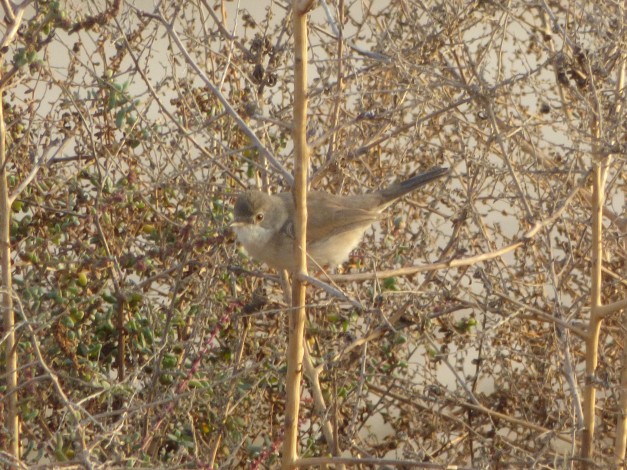
After driving for 5 minutes more we stopped in a different place and scanned around. 3 Isabelline Weathears were found along with the first Desert Wheatear of the trip. Up in a tree, a wonderful Southern Grey Shrike was looking for an evening meal. The last bird of the day turned up to be a Red-tailed Shrike!
Happy for the good birds of the day we just came back to our hotel for a good rest and dinner.
Day 3. Today we were leaving Muscat and starting our way South. Inmediatly beyond the city, an impressive spine of mountains goes up until 3000 metres high. This is area is home of very interesting birds, some of them unique. During that morning we crossed the mountains, spending some time in a key location looking for some of them.
Here the landscape is controlled by towering bare mountains speckled by small elevated plateaus. In the untouched valleys you can see sparse acacias in an semi-desertic ambient. Our first stop was really a random one. As always scanning the sky we finally got a good bird as 1 Egyptian Vulture was spot high up in the sky. It happen that it was a good place where to stop so we did so and, eventually, scanned around. At the other side of the road we got a Red-tailed Wheatear, a really good bird that may not appear in every tour. All the group was delighted with this little wheatear when a small, whitish bird appeared from the right, moving low in the scrubs. It was an Asian Desert Warbler! It was an amazing to see these two really good birds together! The Asian Desert Warbler flew off and, as not everybody in the group had got good views, we decided to do a short walk around. After some 5 minutes of scanning we relocated the bird and everybody had brilliant views on the tiny bird.
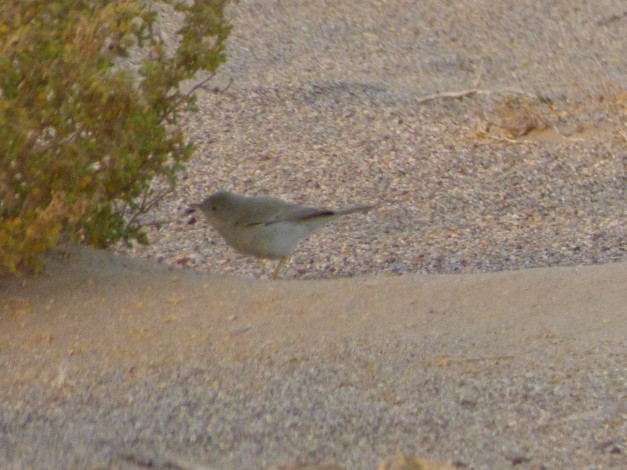
Only a small point on the Asian Desert Warbler. I’m personally used to see African Desert Warbler and I was glad to see how different both species are. More than what you can expect from the plates. Asian Desert Warbler is far more grey than its African counterpart and the grey body is having an evident contrast with the orangish tail. In the African Desert Warbler, all body is strong sandy colourated.
Our road stop also produced Isabelline Shrike and Northern Wheatear. We still drove for about half an hour before arriving to our next stop, a gorgeous gorge with a wadi and a pair of oasis-like corners. This is a well known place for the recently discovered Omani Owl, one of the main targets in the trip. As we got inside the gorge we had several Striolated Buntings singing around as well as Lesser Whitethroats in the scattered trees, Purple Sunbirds, Pale Crag Martins and 4 different Egyptian Vultures. Here we spent several time scanning some roosting places of Omani Owl but with no result. Then we moved up in the wadi until a small oasis. In the way, a Bonelli’s Eagle made us stop and it was a good decision to do so since we had 1 Lappet-faced Vulture appeared high in the slopes and showing really well for half minute! This was a bird really celebrated by the group!!
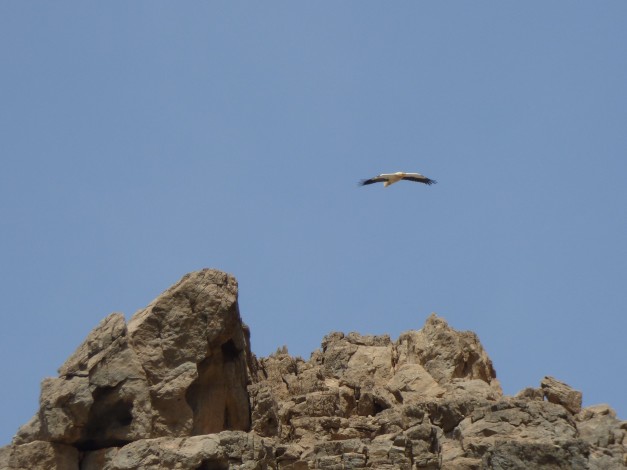
Once arrived we walked a bit around. An obliging Red-tailed Wheatear was a good chance to compare the species with other wheatears while taking some shots. Nearby, 1 female Common Rock Thrush was also showy in the rocks. This is a quite scarce overwintering bird in Oman. A further walk lead us to a small group of trees. Here we easily located the firsts Plain Leaf Warblers and we had a good time enjoying the nervous moviments of this tiny Phylloscopus until the whole group had good views on them. There were al least 5 birds there! Here, a Hume’s Leaf Warbler was also calling in the canopies. We kept scanning but nothing different appeared until 2 Bonelli’s Eagles adults flew over soaring fast and disappearing beyond the gorge.
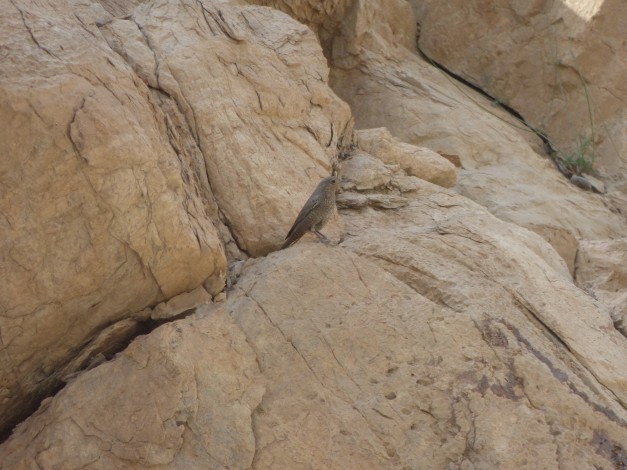
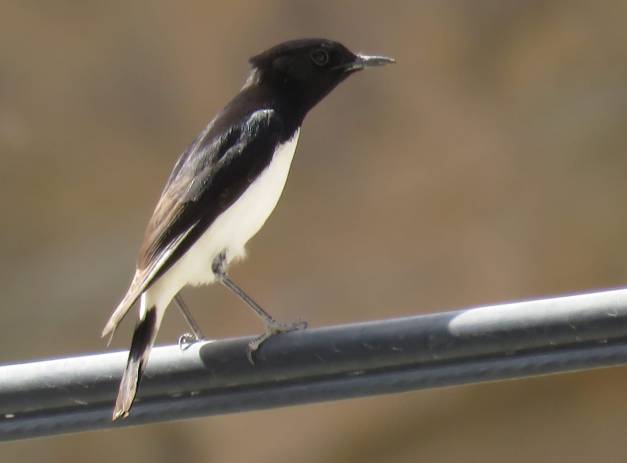
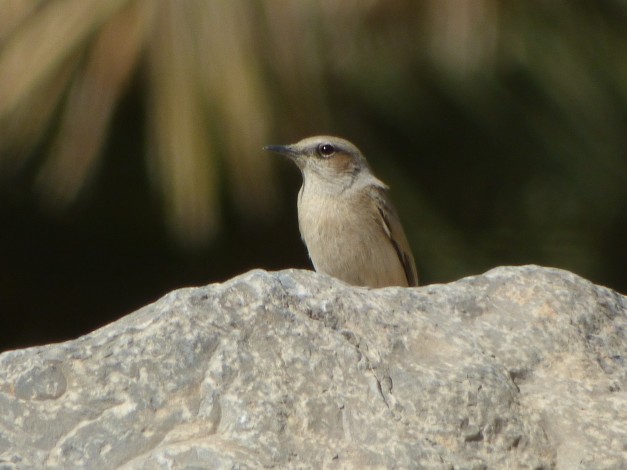
After lunch we left the mountains, crossing the desert in our way to our accommodation inland Oman. Before sunset we did a small stop in a suitable place. Here we got good views on Brown-necked Ravens, Desert Wheatears, 3 Black-crowned Sparrow-Larks (1 male, 2 females) and 1 Asian Desert Warbler.
After such a successful stop we came back to the place where Omani Owl has been seen in recent years. We searched quite long and waited until sunset, but nothing. We were about to leave, already quite dark, when suddenly an owl just appeared from the cliff, diving into the dark, we barely had a view with our torches before the bird disappeared in the dark. We still had 30 minutes more of reseach but unfortunately we could not have any other sight. At some point we decided to move to our next accommodation, with a convenient stop in the way so we could have some dinner.
We arrived to our accommodation, and recharged energy for the coming day.
Day 4. This day was basically a road day in our way to Salalah. After breakfast we headed to Qirbit for some morning birding. Once the oasis by Qirbit we did a walk around expecting some small birds. The desert around was hosting some Desert Wheatears and we got really good views on our 3rd Asian Desert Warbler for the trip. A aucheri race Southern Grey Shrike was calling from the oasis vegetation and several Eurasian Collared Doves were around. We spent about 25 minutes at the oasis and we only got 2 Lesser Whitethroats and 1 Black Redstart.
After such a disapointing numbers we came back to our Qitbit to explore the gardens. These gardens have been really famous for several years and a must for every single birdwatcher exploring inner Oman. Unfortunably the motel in Qitbit is now close and the gardens abandoned so the variety of birds here has collapsed. We didn’t know about we it was evident that the place had once better times. We still had a good surprise in the gardens since a Black-throated Thrush flew off from one of the trees!! The moved into a dense vegetated patch and we decided to follow it. After some wait we had the bird flying to a small pond of water and got good brief but good views on the bird while drinking water.
As Qitbit was disapointing for us in terms of birds we kept driving some more miles South to arrive to a number of farms where irrigation allows a variety of grassy crops. It was midday so quite hot but we still were expecting some good birds. Along the track accessing the farmland we had a number of good birds including several Isabelline Wheatears along with some Desert and Northern. The area was literally full of grasshopers so the presence of 1 Isabelline Shrike was justified. In one of the stops to check around we got 3 Black-crowned Sparrow-larks singing and moving around. Crested Larks were all over. A random stop produced wonderful views on 1 Long-billed Pipit by the car, and everybody enjoyed quiet long. Around, several Tawny Pipits were also seen, some of them performing superbly.
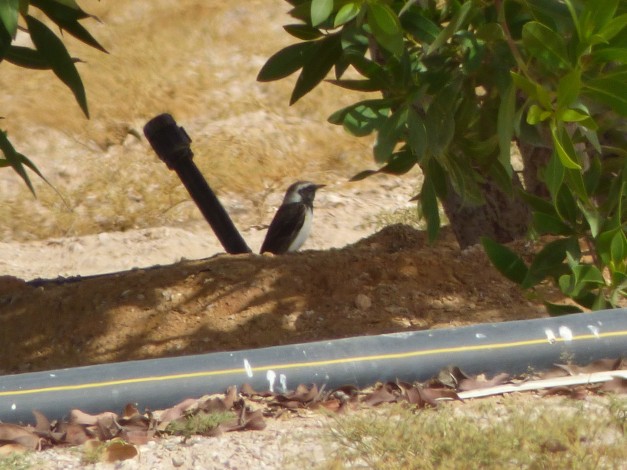
Once by the crops we noticed an even higher density on Wheatears and also Tawny Pipits. 2 Pied Wheatears including a moulting young male were an excellent adding to the tour list. A little walk by the grass produced several Yellow & White Wagtails and we all surprised to listen 2 Quails singing in the field! Several Laughing Doves were in the area, and this was the first place where we noticed the dark form of this beautiful species. The walk was not especially interesting until we got a bird landing in the field. It was a small lark. It was a Skylark actually. It was moving along with a White Wagtail and it looked clearly smaller, thin-billed than the European Skylark. Then a Common Kestrel appeared so all birds flew off to confirm the bird (birds as it was a second one!) to be Oriental Skylarks thanks to the wing patern when flying (mainly the lack of white stripe in the …..
We still spent some more time in the fields. The Oriental Skylarks flew really far away so no chance for a relocalization. After some time without any relevant activity we decided to leave to Salalah.
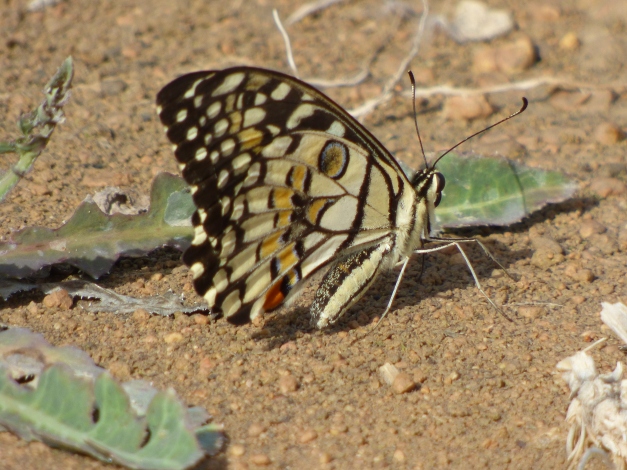
Before living we invested some time on butterflies. Here it was a great variety so we enjoyed some of them, taking good images. After a good driving we finally approached the incredible Jhoffar Mountains. Here, in the road mountain pass, we did a fast stop to enjoy some birds. The firsts of many Fan-tailed Ravens were seen around, offering good chances for photographers in the group. Also Tristam’s Starlings were really showy, with small flocks of about 10 individuals moving around. The short stop turned in a longer one since a small flock of Wagtails included some interesting ones. There were 4 White Wagtails and some Yellow Wagtails including a male Balkan Yellow Wagtail (feldegg). A proper scanning in the White Wagtails produced a Masked Wagtail (personatta) in winter plomage. Beyond the wagtails, an large area of graminea was covering part of the slope. There we saw a small flock of Singing Bush Larks moving around, flying up and down to disappear in the tall grass. Despite our efforts, we couldn’t have a view of the birds on the ground, yet.
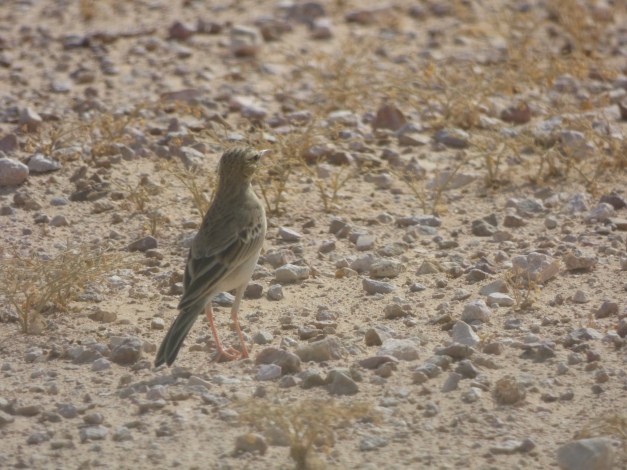
There were also some raptors in the area. 1 Common Kestrel was hovering in the area around and 2 wondeful males Montagu’s Harriers passed by the highway with lovely afternoon light. In the distance, 1 Short-toed Snake Eagle was also a good spot!
After such a productive end of the day we arrived to our accommodation in Salalah for a god rest after a long driving day!
Day 5. After a wonderful breakfast in our hotel in Salalah we left towards Raysut, expecting to spend the whole morning in the area. Still, before heading to Raysut we invested 1 hour in a small wetland near our accommodation. Here we got the first views of many of Rüppel’s Weavers, including a wonderful male building a nest. The ambient was clearly warmer than in Muscat. Along with Rüppell’s Weavers we got Graceful Prinias, as common as in the Northern part of the country.
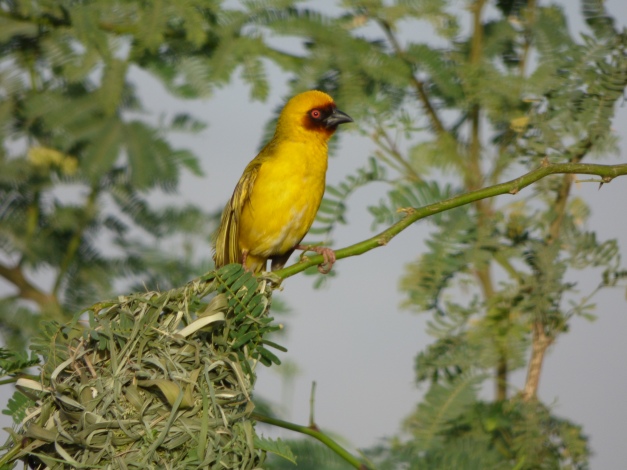
The small wetland is in fact a river mouth, known many times as Eastern Salalah Wetland. Here, the floating vegetation was perfect for a number of species and many Eurasian Moorhens were seen taking advantage of it. A Great Reed Warbler appeared from the riverside vegetation while Wood & Green Sandpipers flew around. 7+ Citrine Wagtails were seen feeding, walking and a very obliging stopping really close. In the open water it was a good flock of 15+ Tufted Duck along with Northern Shovelers and Eurasian Teals. But the lagoon was having also one of the most celebrated birds of trip, a small flock of 8 Cotton Pygmy Geese were roosting in the center of the lagoon, providing good views when one of the males put its head up for a pair of minutes! Happy after this happy encounteer we kept scanning around. Both shores were having some Squacco Herons and, at least, 2 Indian Pond Herons were along with them. Some Gull-billed Terns were flying over the lagoon, joined by 1 Whiskered Tern. A further scanning in the right shore, where more floating vegetation was concentrated, produced 1 Pheasant-tailed Jacana swimming along Moorhens!
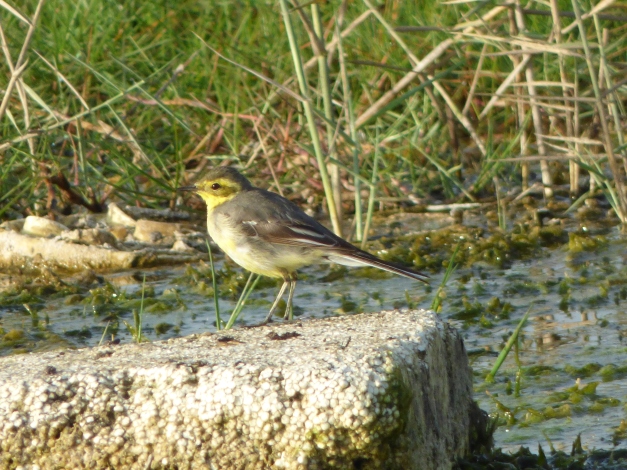
The group was really satisfied after these nice findings. In our way back to car a Common Chiffchaff came across our way and stopped in a branch, preening.
We left the area towards Raysut. The place is well known due to the great concentration of eagles, mainly Steppe Eagles, but also other interesting species. Even before arriving to the rubbish dump we had our firsts Steppe Eagles flying over in a wonderful variety of plomages that will make enjoy every single raptor lover! When being closer we counted hundreds of them circling in the sky, taking advantage of the first thermals. We knew that earlier that week somebody estimated about 500 Steppe Eagles to be in that rubbish dump. Well, they were probably right! Along with the Eagles we also saw a more impressive spectacle: Hundreds of Abdim’s Storks circling in two different flocks! Previous census numbered in about 150…Here there were at least 300 of them!!
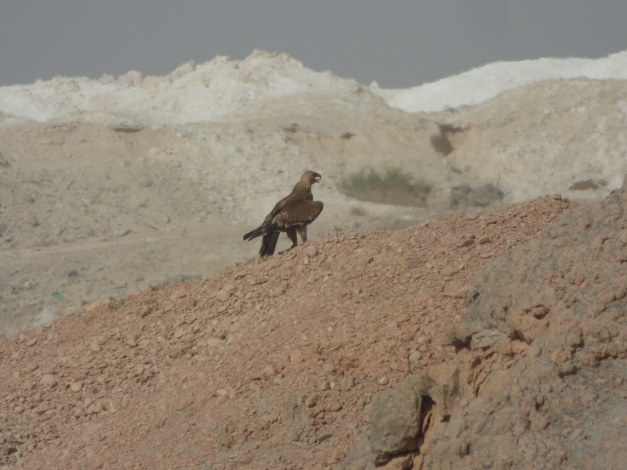
Happy about this incredible spectacle we drove a bit expecting to find some raptors on ground. No long drive was required. After some hundreds of metres we got at least 6 Steppe Eagles on the ground in a wonderful set! We took our time studying the plomages and structure of the birds and, after that, we drove to some lagoons SW from the dump. Unfortunately the lagoons seemed to be totally dry and only a handful Tristam’s Starlings and a pair of Desert Wheatears were left in the place.

We then decided to move towards the coast, to find a different lagoon. Overpassing with the car it was evident that it was having water. A flock of 20+ Greater Flamingoes were there, feeding in the deepest part of the lagoon. At the other side, with small lagoon of shallow water and wide areas of rocks, a party of 150+ of White Storks were roosting, preening or tentativally trying to catch a fish or something from the minor lagoons.
We parked and walked until an apropiated view point. 2 Caspian Terns were flying up and down the river. Lower, 1 Whiskered Tern was doing so, stopping sometimes by a solitary Squacco Heron. Some Grey Herons were also in this part of the river. Tens of Rüppell’s Weavers were in the reeds and their whistles were a constant sound in our ears. In the sky, 2 Western Ospreys were patrolling the lagoon. One of them tried for 4 times to catch a fish but with no luck at all…Finally flew the area toward to sea in a short flight, probably to rest and wait until better times to come. The sky was providing a lot of activity. 4+ Black-eared Kites (race lineata of Black Kite) were also patrolling the sky, probably unhappy after the unsuccessful attemps of the Osprey. Waves of birds of prey were coming down the river from the rubbish dump, located some miles up by the river. They were mainly Steppe Eagles but along with them we spotted our firsts 2 Eastern Imperial Eagles of the trip! An intense scanning of the raptors produced also 8+ Greater Spotted Eagles circling and also stopping in the cliffs by the lagoons. They were clearly coming to take a bath and drink water. One of this Greater Spotted Eagles came down the lagoon and stopped right in front of us! An amazing view of such a incredible bird. Delighted after such a wonderful sights we walked a bit down the lagoons, approaching the area of pools were most of Storks and Herons were. We didn’t cover a long distance before we had to stop again due to 2 magnificent Great White Pelicans flying low over us. This a species considered as a rarity in Oman so we were not really expecting to enjoy them in this tour! The birds passed by us going to the see, joined by a small flock of Barn Swallows.
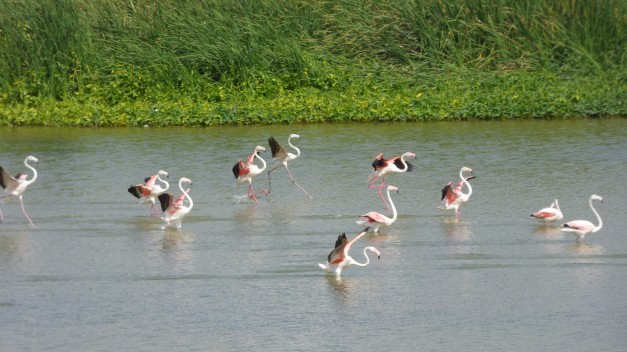
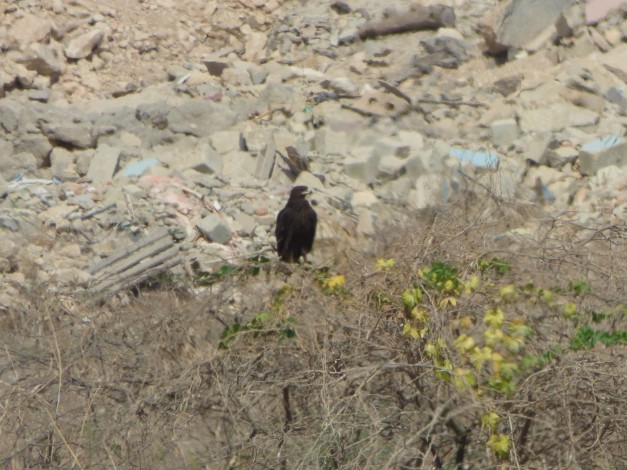
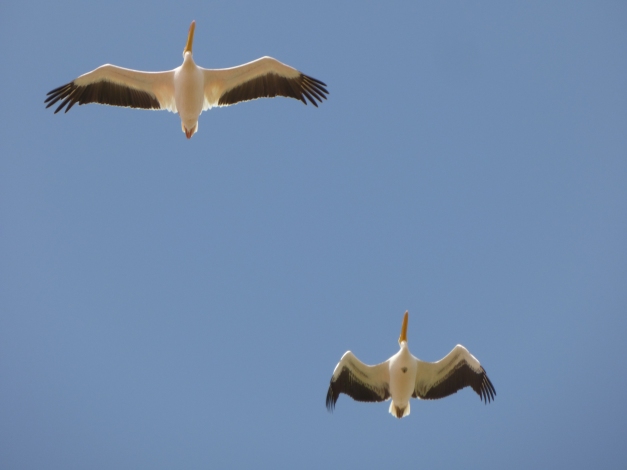
The ponds were fullfilled with birds. There were 120+ Grey Herons roosting in the roocky river bed, beyond the ponds. Along with them there were some Western Cattle Egrets, 1 Little Egret, some Western Reef Egrets (both white and dark forms) and 1 Intermediate Egret. The ponds were hosting Common, Wood & Green Sandpipers but also Greenshanks, Common Redshanks, 3 Ruffs and some Temminck’s Stints. A wonderful Pheasant-tailed Jacana already developing the typical breeding long tail projection was really showy and allowed some record shots. Here we also had good views on the impressive Pearl Emperor (Charaxes varanes) female, a wonderful large butterfly that flew over our group!
Beyond the ponds, the massive flocks of White Storks and Grey Herons were, for sure, hiding something else so we started scouting them. 1 African Sacred Ibis was found, to turn into 3 individuals later in the day. Also 1 Glossy Ibis was discovered feeding in what we supposed was a tiny pond. Beyond the Herons and the Storks, 1 Greater White-fronted Goose was moving in the scattered rank vegetation.
Beyond this area a small estuary was concealling the stream and the sea. A fast scanning concluded some 1000s of waders but also 4 Western Ospreys and some Greater Spotted Eagles on the beach. We just decided to come closer abd have a good scanning.
The area was simply great. Thousands of waders were feeding in the mudbanks. Many Dunlins, tones of Little Stints but also Common Sandpipers, Common Ringed Plovers, Common Redshanks, Greenshanks, Bar-tailed Godwits and some Kentish Plovers of the witish local race. 4 Eurasian Oystercatchers were counted along with several Eurasian Whimbrels. Here, some Lesser Sand Plovers were seen but the most popular wader were the Terek’s Sandpipers moving around. We counted at least 23 of them, some of them doing their typical short runs in search of food. These birds are authentical runners!
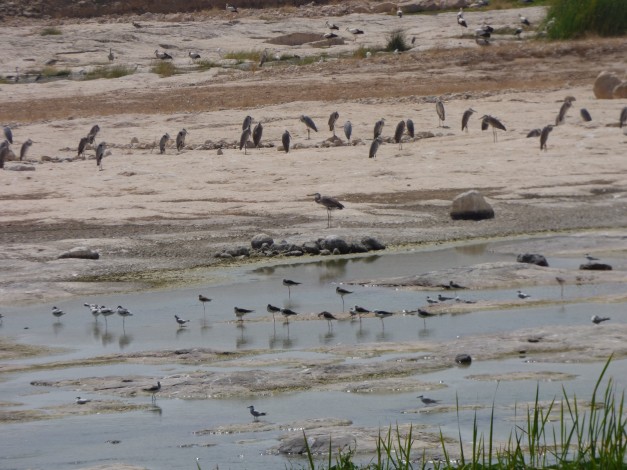
In the sea, flocks of Socotra Cormorants were moving up and down and we enjoyed a pair of their typical massive flocks. Greater Crested, Lesser Crested & Caspian Terns were all around but the most interesting were two Saunder’s Terns moving South along the coast in what it turned out to be the two only Saunder’s of the tour, a species we were expecting to be commoner.
The area was really interesting. Also for gulls. Here we had good views on Heughlin’s, Steppe Gulls and also Caspian Gulls. It was funny to go throught the flock of gull, with some unclear individuals and many other showing typical characters of any of the species. A solitary Palla’s Gull was also noted in the flock.
The bay also produced good views on Delphins. In fact we got two different species with a small party of Indo-Pacific Bottlenose Dolphins and at least 1 Indian-Ocean Humpback Dolphin moving close to them.
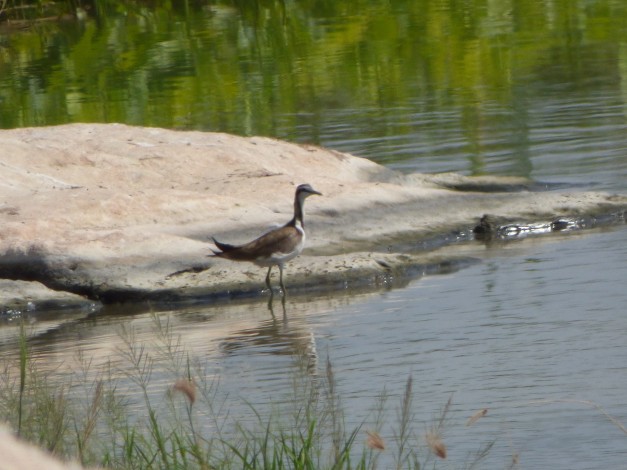
After such a wonderful morning we just had a break for lunch. After our break it was time to go up in the hills to look for a number of other species. Now the landscape changed a lot with mild hills covered by a carpet of small decidous trees, with the impressive Dhoffar mountains in the back.
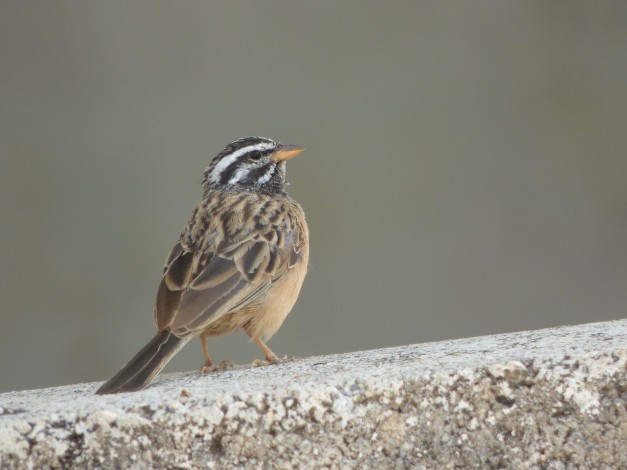
Flocks of Rüppell’s Weavers jeweled the road as we were approaching the location. African Silverbills joined them. Few minutes later the whole group was enjoying wonderful views on Cinnamon-breasted Buntings and Abyssian White-Eyes. Many of them were coming to drink water in a small channel.
A short walk around was soon producing interesting birds including Palestine and Shinning Sunbirds as well as a lovely flock of African Silverbills. White-eyes were extremelly common , moving up in the canopies but also low in the branches, few inches from the ground. One of these flocks brought associated a lovely African Paradise Flycatcher, one of the most celebrated birds in the afternoon. In total, we counted up to 4 individuals, including one showing a full breeding tail in whitish colour!
The walk was being very productive, especially after 2 Blackstarts appeared really close to the path, delighting us with cracking views! The lower vegetation around was also promising so we went a bit out of the bigger trees to take a look. It proved to be a wonderful decision since we soon had 1 Arabian Warbler moving in one of the small trees. The bird showed nicely and its movements reminded us those of an Orphean Warbler. Right side by side from the Arabian Warbler we had another surprise since 1 Black-throated Tchagra pop up from the very dense vegetation to give us poor views. The bird was moving really low in the scrubland so a bit of wait was necessary until the bird decided to “jump” into the open for half a minute!
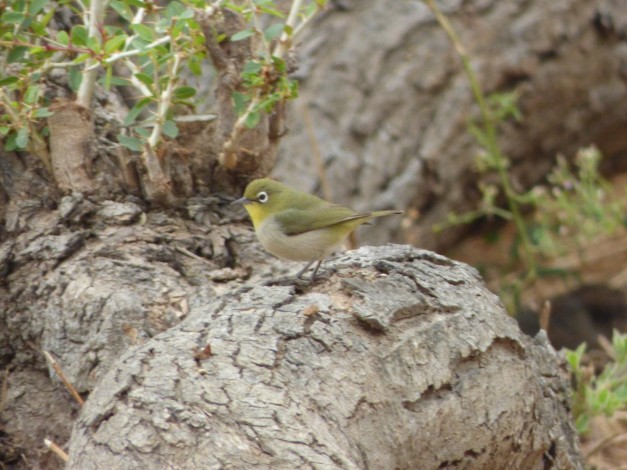

The locations was proving to be really productive and the landscape around was dominated by the impressive rock faces of the Dhoffar mountains. Here the cliffs were monitored by a good number of raptors. They were mainly Steppe Eagles but we could also see 3+ Eastern Imperial Eagles, 1-2 Greater Spotted Eagle and 1 Golden Eagle.
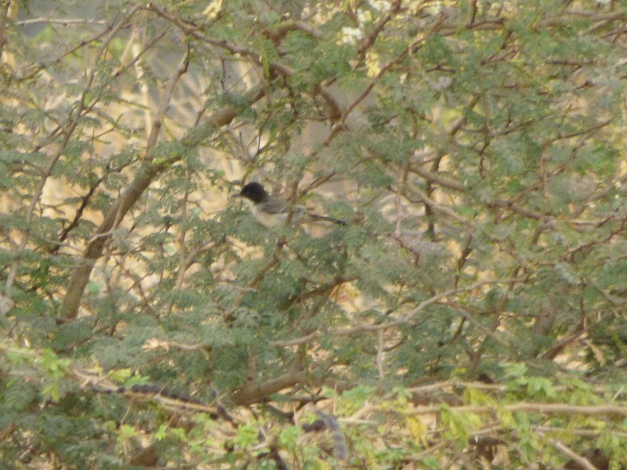

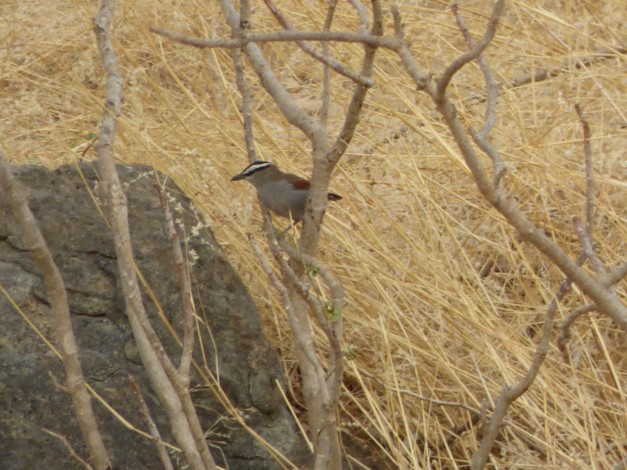
Before heading to our accommodation we still had a last spot to try to add something else but we only added 1 male Blue Rock Thrush and several Isabelline Wheatears along with a superb Greater Spotted Eagle overwatching the whole area from a pilon.
Day 6. This day we drove some miles North from Salalah to enjoy our sea trip in search of some of the specialities living in this part of the Indic Ocean. The small harbour from where we depart was full of Sooty Gulls, alowing really close views on this lovely species. Moreover, the harbour was also hosting several Heuglin’s Gulls and some Caspian & Steppe Gulls. Inmediatly after our small boat left the harbour we had the first surprise in the form of a flock of Black-crowned Black Herons roosting on the external deck boulders. There were not alone but joined by several Gulls, some Grey Heron and 2 Western Reef Egrets. As the boat passed by we had really good views on the Herons.
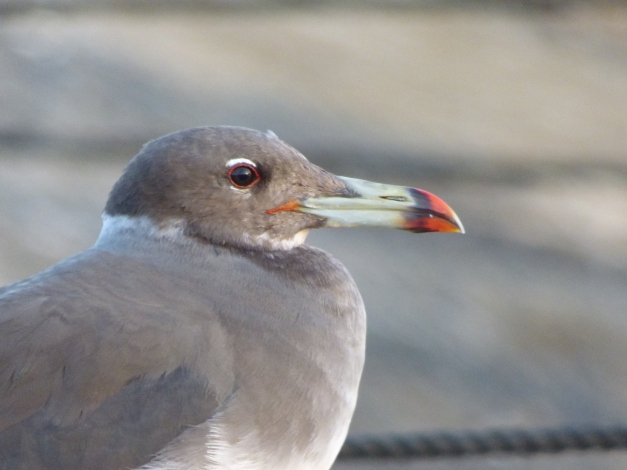
Once in the open sea we started a hard work to attrack the some sea birds. Soon, a number of Sooty Gulls were following the small boat. A few minutes later we had the first target appearing in the way of a small flock of 3 Persian Shearwaters flying above the waves. Unfortunately they appeared as not interested in our small boat and kept flying away. Encouraged after such a good start we kept going off shore. Flocks and flocks of Red-necked Phalaropes were all over on the extremelly plain sea and their pure white bodies were like tiny lighthouses in the deep blue sea.
We enjoyed several close views on them but take good photos on them proved to be more difficult than expected.
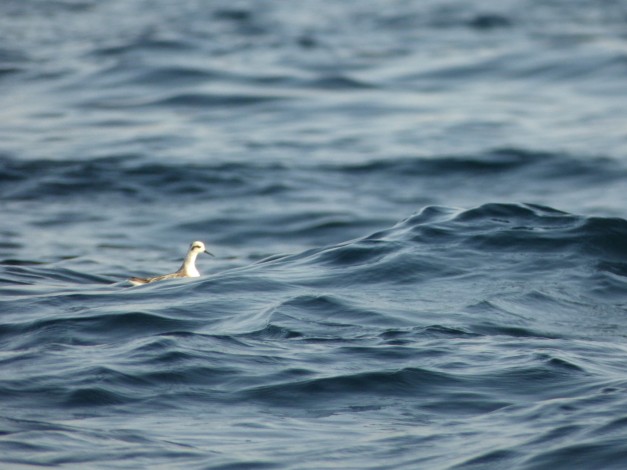
The boat trip was going well but even improved as the 2 Masked Boobies flew over our boat! Great views on a really celebrated bird that, unfortunately seemed to have no interest at all in the food we were offering them. We kept scanning and feeding for long, expecting to attrack a Jouanin’s Petrel, one of the top targets in the offshore trip, but we had no luck in this…
We enjoyed up to 14 Masked Boobies with some great views and a second flock of Persian Shearwaters passed by us but no signal of the Petrel. Midway in the sea trip we got excellent views on Indo-Pacific Bottlenose Dolphins and enjoy some great views on them while jumping in the waves and chasing tunas. A Green Sea Turtle was also a good addition to our list! It was a quite large one (about 1,5 metres) and it was in the surface only for few seconds…
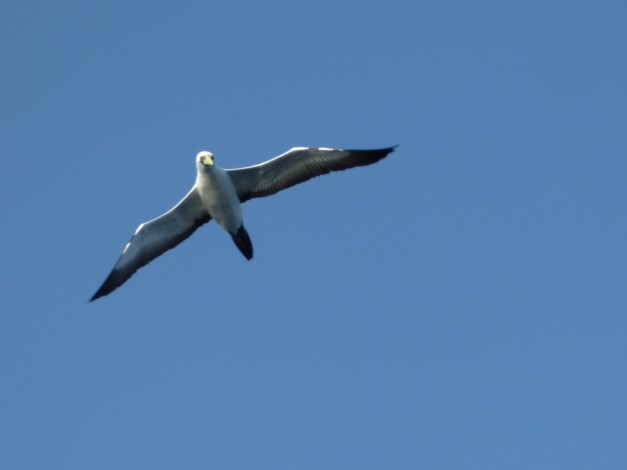
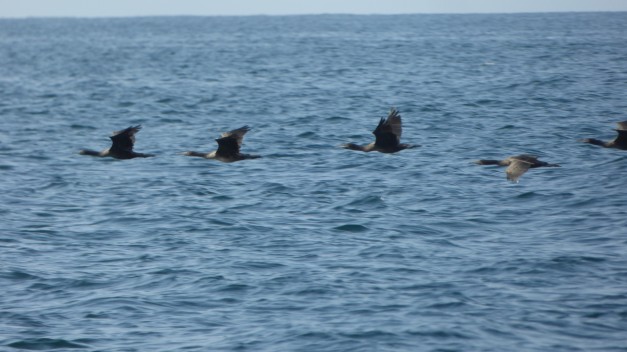

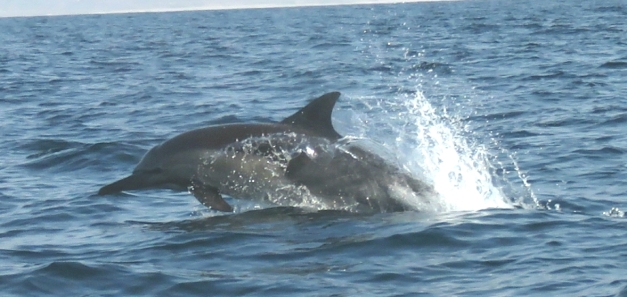
Once back on the continent we just went for something to eat. Happy for the relative
good sights during the sea trip we just changed and went to the explore the highest area in the Dhoffar Mountains. A number of lanes go up in the slopes, allowing excellent birding all around. The way up produced excellent views on Long-billed Pipit, Blackstarts and Isabelline Shrikes.

Once in the high plateau we were lucky enough to enjoy a nice flock of Cinnamon-breasted Buntings, Long-billed Pipits and wonderful views on Singing Bush Larks. Beyond there, a male Arabian Wheatear Scanning the slopes inmediatly around we found a incredible flock of 20+ Yemen Serins feeding on the ground and showing wonderfully in a rocky area close to the road. We were amazed to have such a great views on this species, being this area the only one place in the world where it is possible to enjoy it!
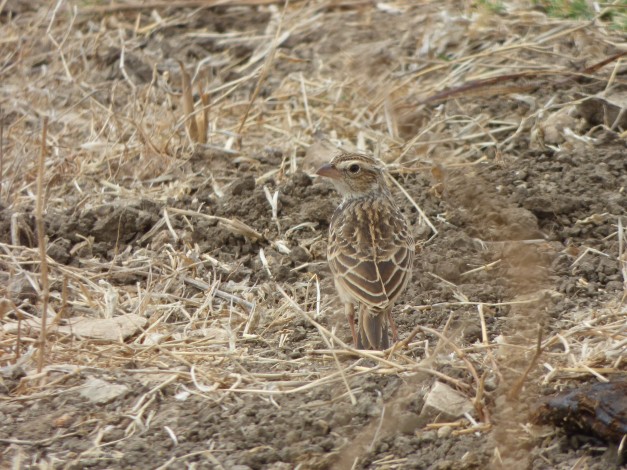
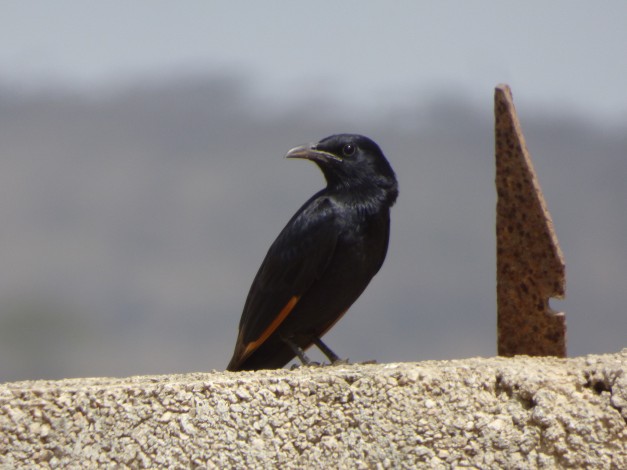

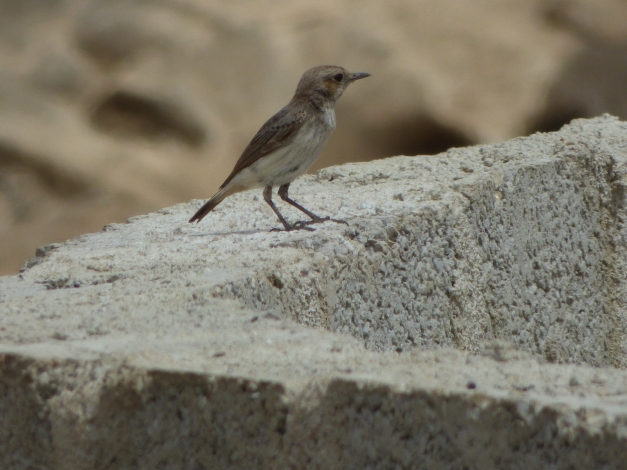
Happy after such a good views on many key species we kept moving in the slopes. Inmediatly around a small village we found 1 Eastern Imperial Eagle on a wood pilon. The bird showed nicely and allowed really good shots! Up in the sky, raptor action was increasing. In less than 15 minutes we counted 7 Eurasian Griffons, 10+ Eastern Imperian Eagles, Steppes Eagles, 1 Short-toed Snake Eagle and 1 Bonelli’s Eagle!
Still, the most wanted Eagle was not showing…yet. In our way up we did also a short stop in a pond and got one of the surprises of the trip.
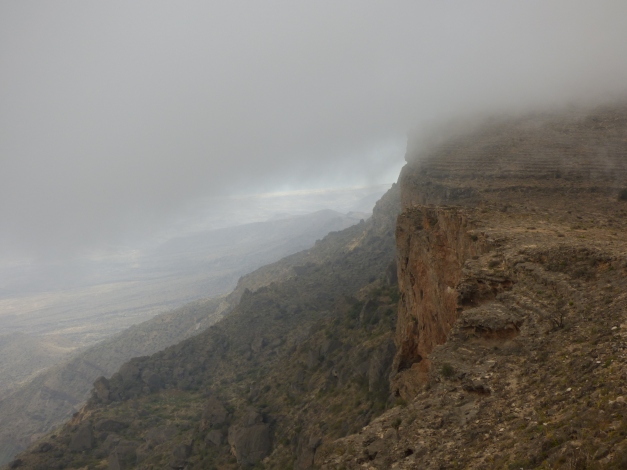
After such a great found we decided a proper stop in a pond and scan around. Many Abyssian White-eyes were moving around and 2 Shinning Sunbirds delighted us with its incredible colours.
Our last stop that day brought us to a wild scarpment. It was really windy and foggy so we were expecting little that afternoon. Fan-tailed Ravens were moving all around the cliffs and the area around produced wonderful views on Tristam’s Starlings. The scanning around was producing little else and we were already considering to leave when an enormous black and white shape emerged from the fog to fly up in the cliff: it was a Verreaux Eagle! The bird was just playing with wind, moving up and down in the cliffside. Few seconds after a second Verreaux Eagle appeared as well from the fog and we all enjoyed wonderful views in what is one of the most espectacular eagles on Earth! The birds kept appearing and disappearing from the bog for at least 15 minutes, doing incredible acrobatical flights and even stopping in the cliffs for short!!
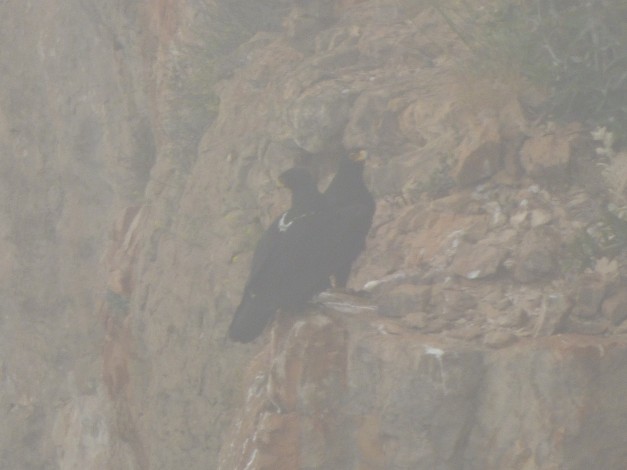
Happy after such a successful afternoon we just headed back to Salalah, where a good last stop was waiting for us. Urban birding in Salalah can be really good so we went to one of its urban parks, close to our accommodation, to finish the day. Out of the common Laughing Doves, one of the first birds we got were to Plain Rock Martins resting in one of the buildings of the complex. They offered good views on a bird we could see in flight so far. Beyond the building a small lagoon offered really good views on a flock of Whiskered Terns and also a pair of Caspian Terns. Citrine Wagtails were quite common in the flooting vegetation and 1 Palestine Sunbird showed superbly in low rank vegetation. 2 Indian Pond Herons were also present, catching the afternoon light in a wonderful way. Passing over the lagoon by a small bridge, we explored a palm tree orchad. Here we got one of the main targets of the visit in the way of 2 Bruce’s Green Pigeons showing in a wondeful way, first in a wire, later on a tree while feeding on fruits. This was again a really celebrated bird for everybody in the group.
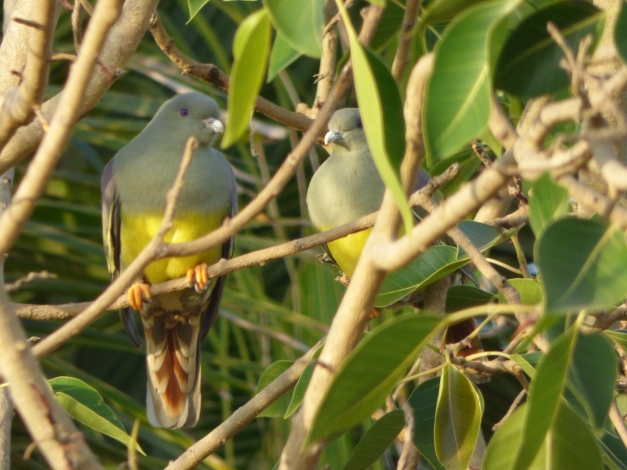
We kept moving in the area. An open field beyond was hosting waves and waves of Yellow Wagtails, including some nice summer plomaged “feldegg” and “beehma” birds. 1 Isabelline Weathear was also really showy in the area, as it was a Graceful Prinia. The channel around is an interesting roosting place for waders and, at that time, tens of Common Sandpipers were concentrating in the area along with 15+ Greenshanks and several Green Sandpipers. Sun was starting to go down but before we left we still had another top target appearing in the way of 2 Spotted Thick-knees posing for us under one fot he small olive trees in the garden.

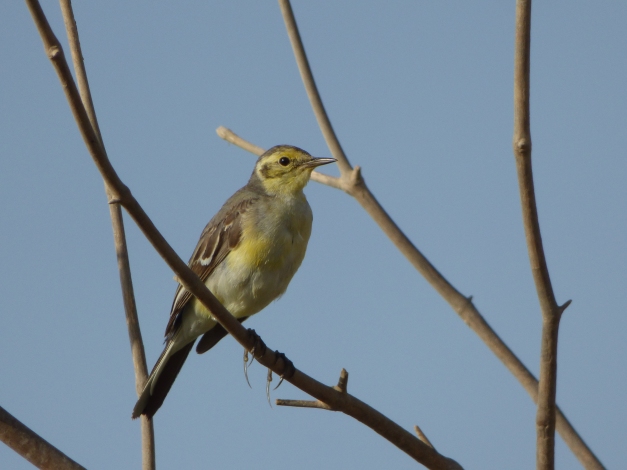
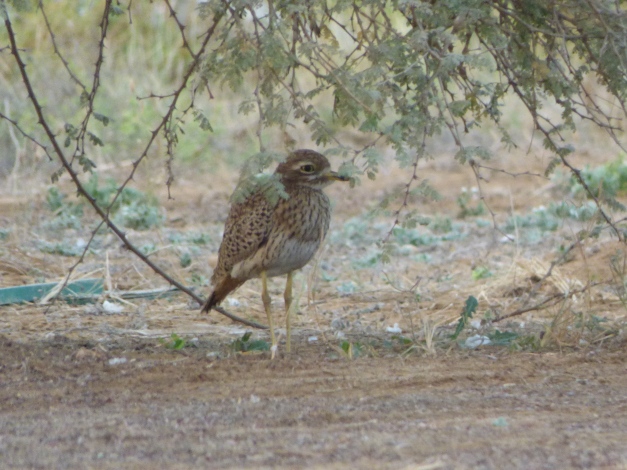
After such a great views we just came back to our hotel to enjoy another great buffet dinner.
Day 7. This day we had a very early start with a small tranfer back to the desert, were in a small oasis we were expecting to find Grey Hypocolius as well as other top target birds. After our transfer we enjoyed our packed breakfast while scanning around. Not long at all until we got the first good bird in the way of a gorgeous mal Nile Valley Sunbird just around our car. Not many time for photographs in this wonderful bird because 1 Grey Hypocolius just flew over us (!!) stopping about 200 metres away from us. We just moved on and after some searching in the area we got brief views on a wonderful male up in a palm tree! But was a brief view as the bird pop down and disappear. Spent some time around with little result out of more views on the male Nile Valley Sunbird, joined now by a female!


We walked around hoping to have the Hypocolius appearing again but we got nothing but a pair of glimpses on 3 of them moving around. Blackstarts were singing around as the sun was getting higher.
Suddenly, a flock of birds appeared moving in the sky, Sandgrouses! A flock of 30 of them was moving in the distance, apparently moving down to drink water in a small pond beyond the vegetation. We just drove down the area, stopping in a decent distance to the pond. And then it came waves and waves of Sandgrouses, calling and flying extremelly fast around the pond. They were mainly Chestnut-bellied but also Spotted Sandgrouses were mixed with them.
First it was a flock of about 30. But then it came a second flock, and a third, and a fourth. Suddenly the sky look like full of them, with flocks coming in and out, landing, walking, flying fast from few inches to the ground or flying up in the sky while calling. This was propably one of the most remarcable momments of the tour. We estimated about 150 Chestnut-bellied Sandgrouses and 30+ Spotteds! In one the last flocks coming in we also got at least 1 Crowned Sandgrouse! It could not be better. Wrong. It could.
Right when all Sandgrouses were flying around with their noisy call, 2 Grey Hypocolious jumped on the wire just by our car, allowing some great views on them. ! female in particular stayed in the wire for about 5 minutes, allowing great images! We especially enjoyed the female, being there for some minutes while the male was only a little while…

More and more flocks of Sandgrouses were coming down to drink water. Now not only in this corner of the oasis but also in many other areas around. So we moved a bit to try to get better views on the different flocks and, maybe, something different. But we were already at the end of the spectacle and we only got closer views on a small flock of Chesnut-bellied Sandgrouses walking right in the tarmac. They were there for a pair of minutes and after that they flew off. Very little movement of Sandgrouses were left already…2 Blackstarts were singing in nearby cliffs. Got a nice view on them before heading back to Salalah.
Back in the coast we decided to spend some time in ponds in Raysut. There we were compensated with great views in a big flock of Abdim’s Stork, a species that we had only in flight until that moment. But in the ponds we had a flock of 200+ having a bath or simply resting in the gravel shore. Along with them, a good number of waders including several Temminck’s Stints and some Little Stints. Little Ringed Plover, Greenshanks and Common Sandpipers were also there.
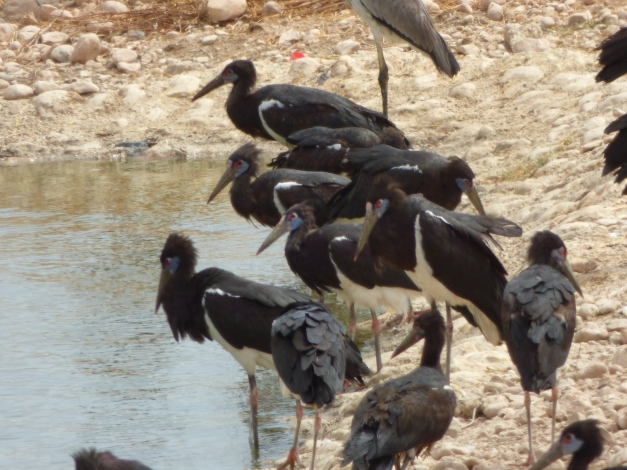
After an early lunch we just got back to the hills. This time we went a bit inside the fabulous decidous forests covering much of Dhoffar Mountains Eastern slopes. Here we enjoyed with several flocks of Abyssinian White-eyes and some African Paradise Flycatchers. A pool in the forested areas produced good views on a male Shikra posted in the shade, waiting for potential preys to come. The trees around were hosting good numbers of Cinnamon-breasted Buntings, Blacktarts but also 1 Siberian Chiffchaff that was calling in the canopies, making much easier to identify the bird. A small walk was done in nearby meadow, where we had a Red-throated Pipit flying over us.
This day we waited until dusk, and then we were to explore an interesting point for Arabian Scops Owl. We just waited until dark and after some minutes we got a wonderful Arabian Scops Owl calling really close to us. It was a question of minutes to get excellent views on the bird, and with the help of special lights we got incredible shots in the owl!
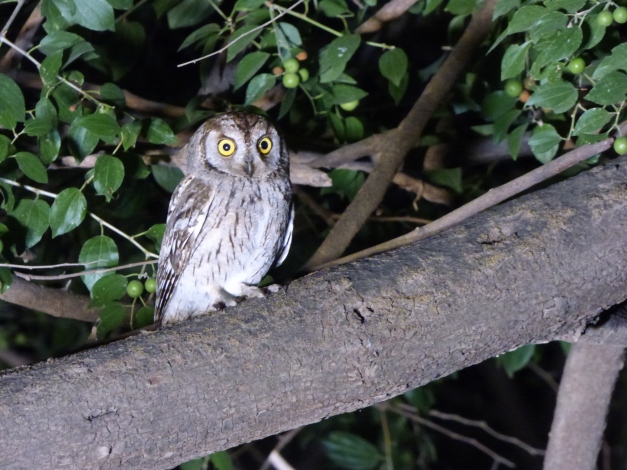
Happy after such a nice views we came back to the hotel for some dinner and rest.
Day 8. That sunny morning we went to try a different place for Arabian Golden-winged Hawfinch. In our way to the little pond were the birds use to come to drink we had a stop as 2 Arabian Partridges were standing by the road in lovely morning sun. Once in the pond, good numbers of Cinnamon-breasted Buntings and African Silverbills were attending the water. We decided to wait a bit. 1 male Namaqua Dove passed by the pond at the same time that a Greater Spotted Eagle was flying over. Few more minutes of waiting and a female Shikra appeared up in the sky, offering good views.We kept scanning around the ponds, were some flocks of Abyssinian White-eyes were also coming. Then, something moved fast around one of the ponds, and a fast scanning produced a Grey-headed Kingfisher! This was a surprising sight since this species is suposed to arrive in Oman during early April (!!). We anyway enjoyed very much this really unexpected bird as was flying around the pond, chasing dragonflies in a really effective way! The bird showed really well for up to 20 minutes, until a big herd of cattle came to drink water.
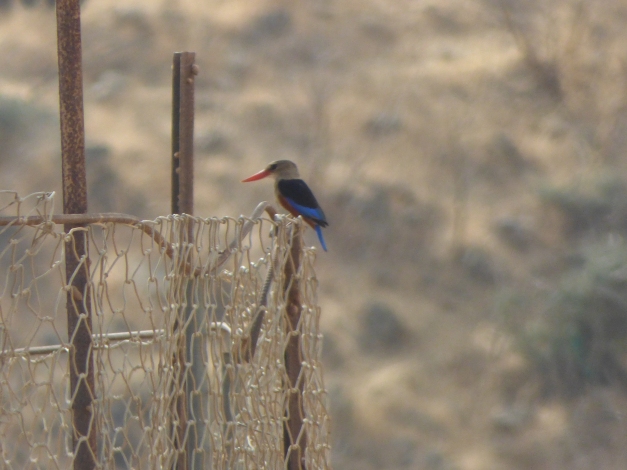
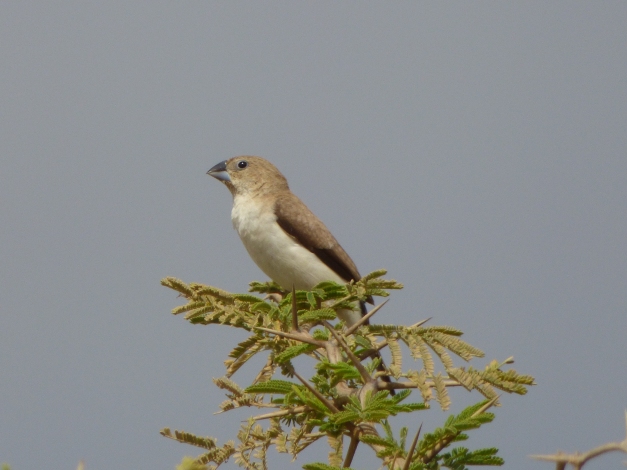
It was already quite and it was clear that Hawfinches were not coming to drink water, so we decided to move, missing this wonderful bird. This day we were facing a transfer North but before that we were still having some time to check the Salalah farms.
We checked s two of them before driving North. In our first location we got Clamorous Reed Warbler and up to 5 Graceful Prinias. The grasslands were hosting several Singing Bush Larks that were singing and performing around. Up in the sky, 4 Forbes-Whatson Swifts passed over us, offering good views in both the general colour and the white spot in the throat. Out of this, the grasslands were poor in birds so we decided to move to a second farm. A drive around this second place produced Hoopoe, Green & Wood Sandpipers and the only one Yellow-billed Kite of the trip. Still, the area was poor again in birds so we decided to leave the area and start moving North.
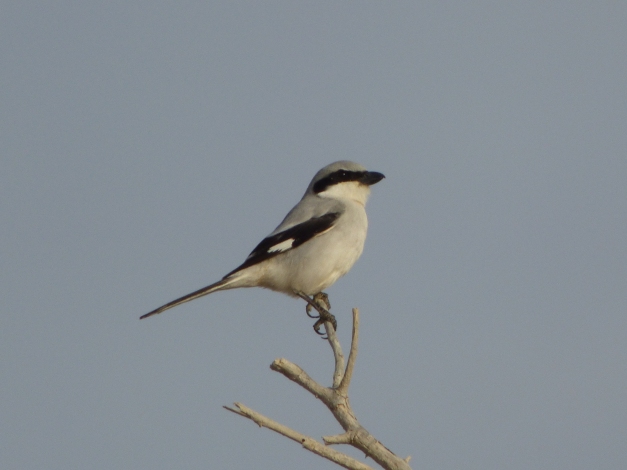
In our way North we did one stop midway. A short walk in the desert produced 1 Chestnut-bellied Sandgrouse, 2 Black-crowned Sparrow-lark and 5+ Greater Hoopoe Larks chasing each other and doing acrobatical flights in a lovely afternoon light. After this good sight we just drive until Duqm, arriving a bit after sunset.
Day 9. This day we ha dan early breakfast and left North to explore the …… Bay. This is huge estuary concentrating hundreds of thousands of waders. When did arrive tide was low and birds very distant. Still, we had good views on several Bar-tailed Godwits, Kentish Plovers, Dunlins, Grey Plovers, Eurasian Curlews and Lesser Sand Plovers. Flocks of Greater Flamingoes were roosting in the water, just few inches inside the Ocean. There were several Caspian Terns flying up and down the area and there were flocks of Sanderlings all along the shore.
Despite this, and after 45 minutes of scanning, we were uncapable to connect with our main target in this point, the Great Knot. So, we finally moved some miles North to keep scanning the estuary but from the Northern side. We drove some 40 minutes scan around the deck where some ferries are connecting with Marisah Island.
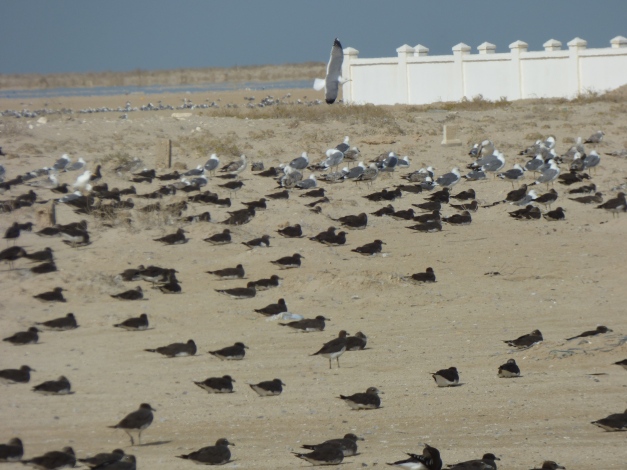
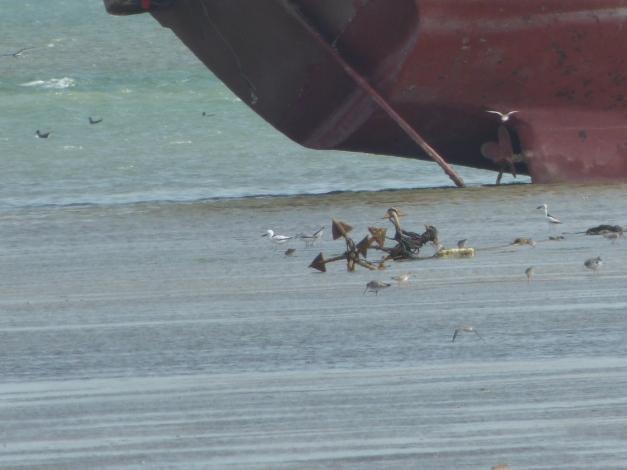
In the beaches around there were literally thousands and thousands of Sooty Gulls. Along with them, huge flocks of Slender-billed Gulls were also a good views. Probably more than 7000 Slender-billeds and number even higher of Sooty Gulls! This wonderful espectacled were complemented by 100s of Caspian and Heuglin’s, being Steppe Gulls the less numerous in the area. A scan along the bridge giving access to the ferries produced a small flock of Common Terns, and not far away from them our only one White-cheeked Tern of the trip! Once in the deck we also enjoyed excellent views on Greater Crested Terns. Back in the mainland it was time for the tide to go down once more. Loads of waders came in. And along with the most common species we had wonderful views in 50+ Crab Plovers feeding in the shore and moving along with Bar-tailed Godwits. They were a bit distant but still this was definately one of the images of the tour for some of the tour participants and for sure a wonderful way to end the trip!
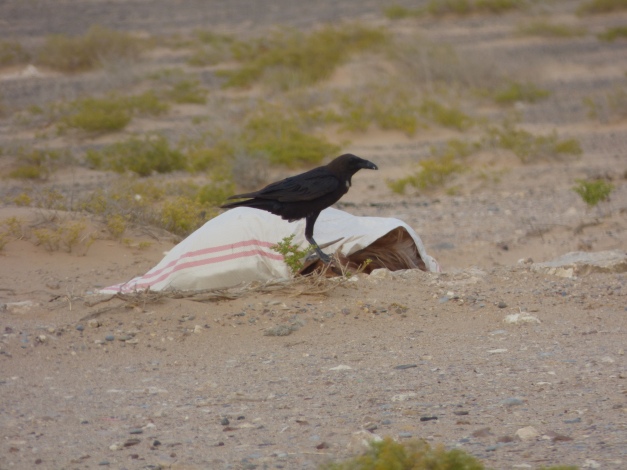
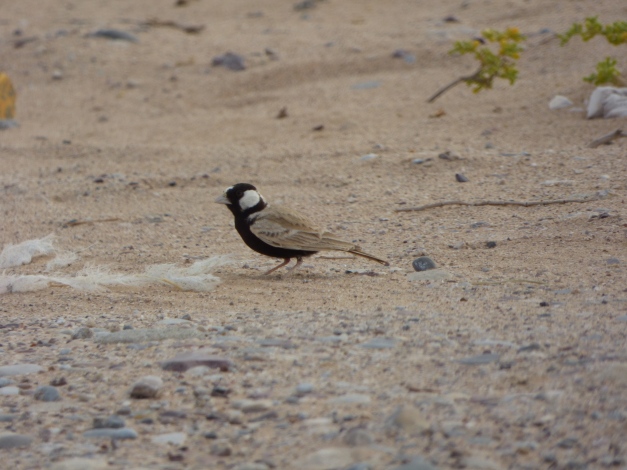
In our way out of the area we still had a final stop since a really close Brown-necked Raven was offering nice views. Close by, a lovely Black-crowned Sparrow-lark gave us the best views on the trip, joined by a small flock of Tawny Pipits! These were the very last birds of the trip. After this we just drove back to Muscat for a nocturnal flight back home after a wonderful tour in Oman!
Please check our website for the upcoming issues of this trip. If not finding the information, please contact us: info@barcelonabirdingpoint.com

